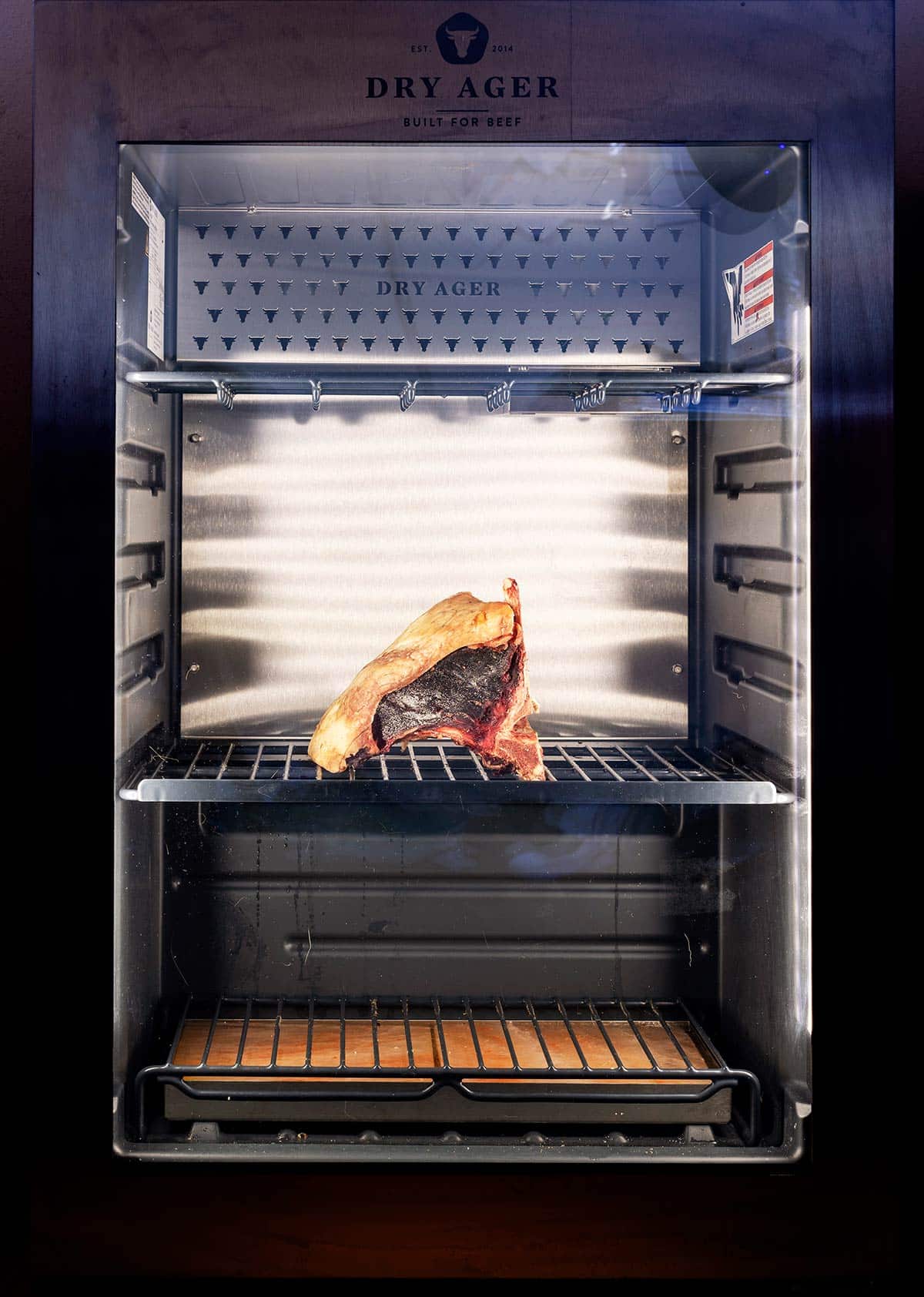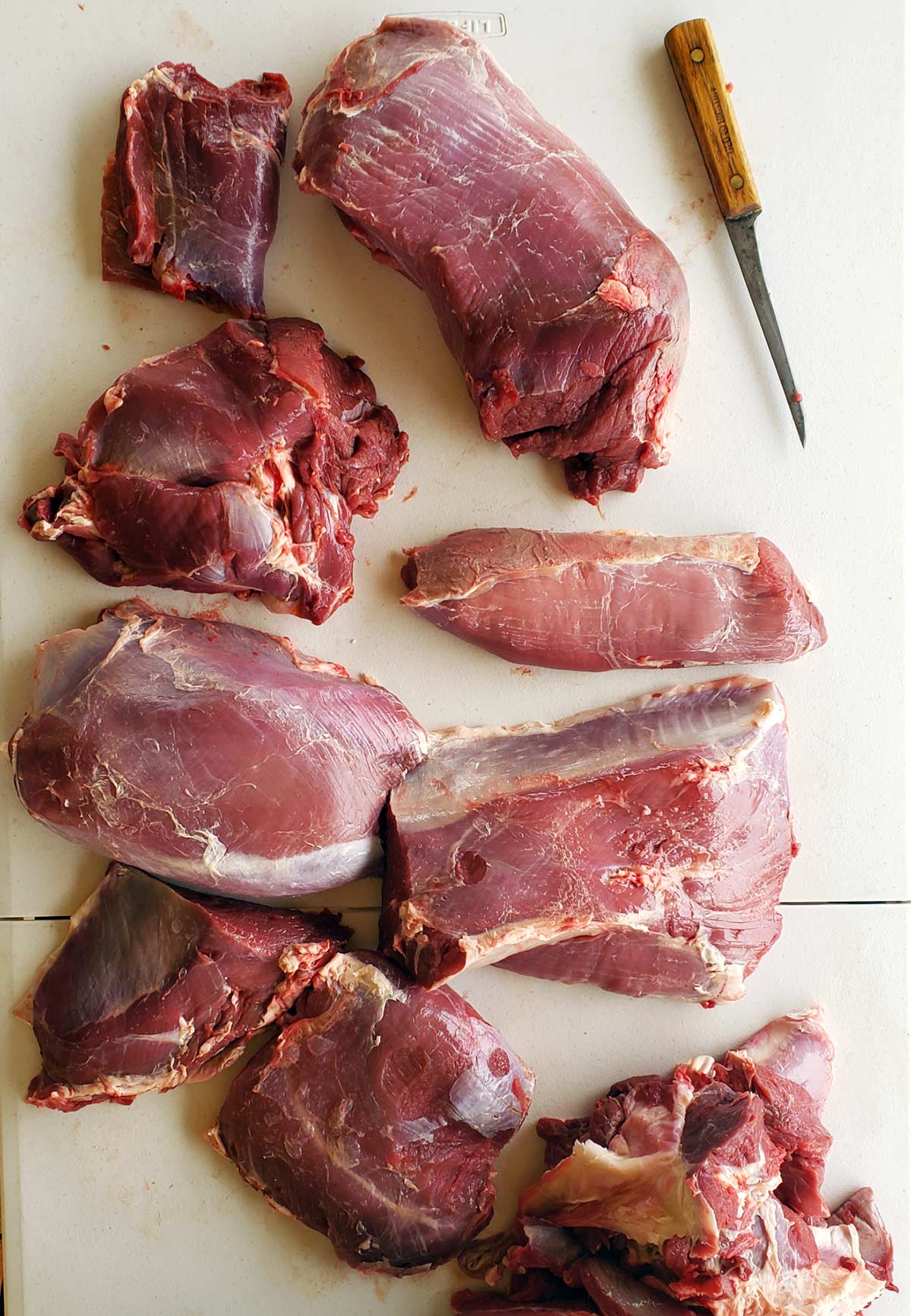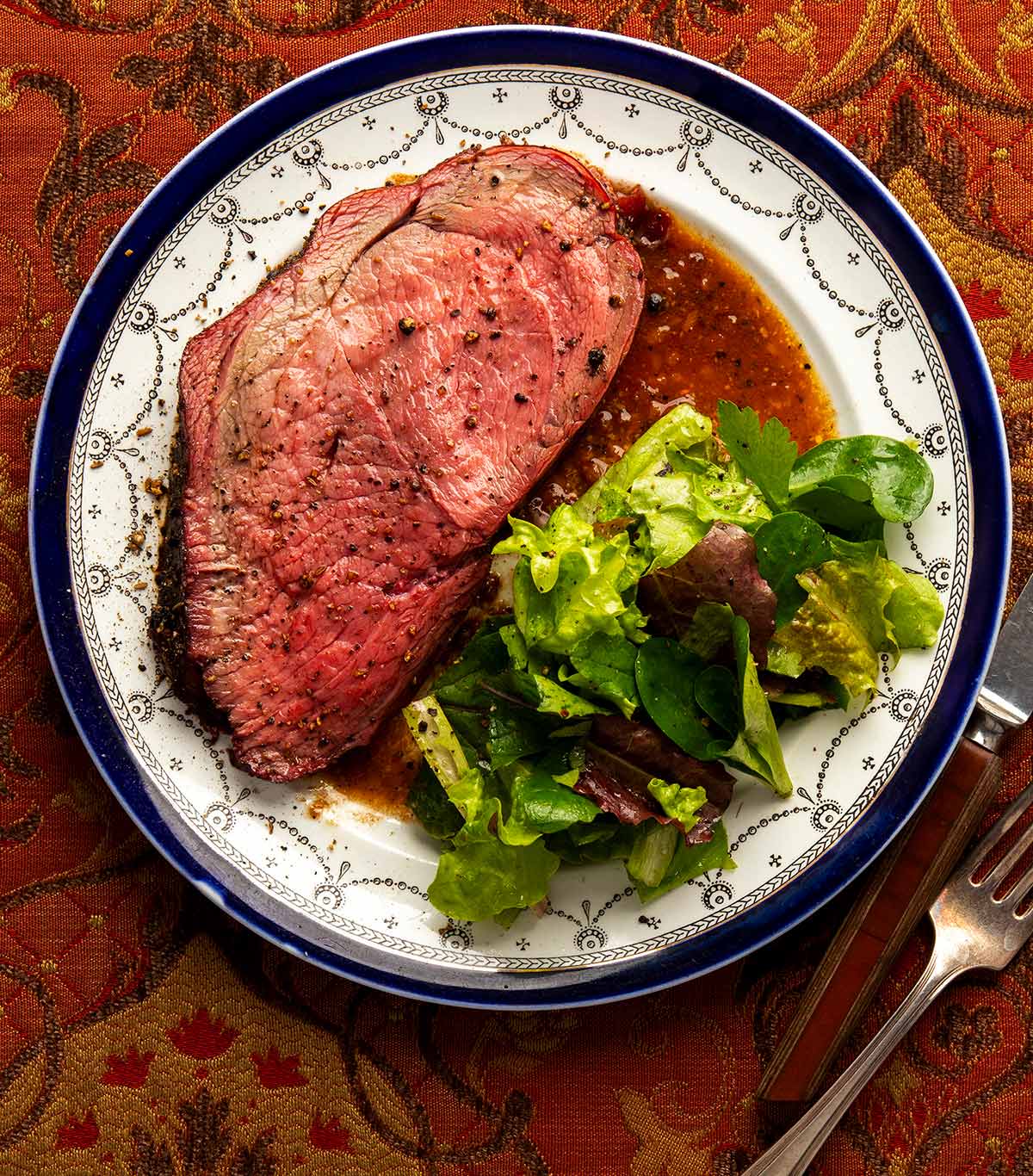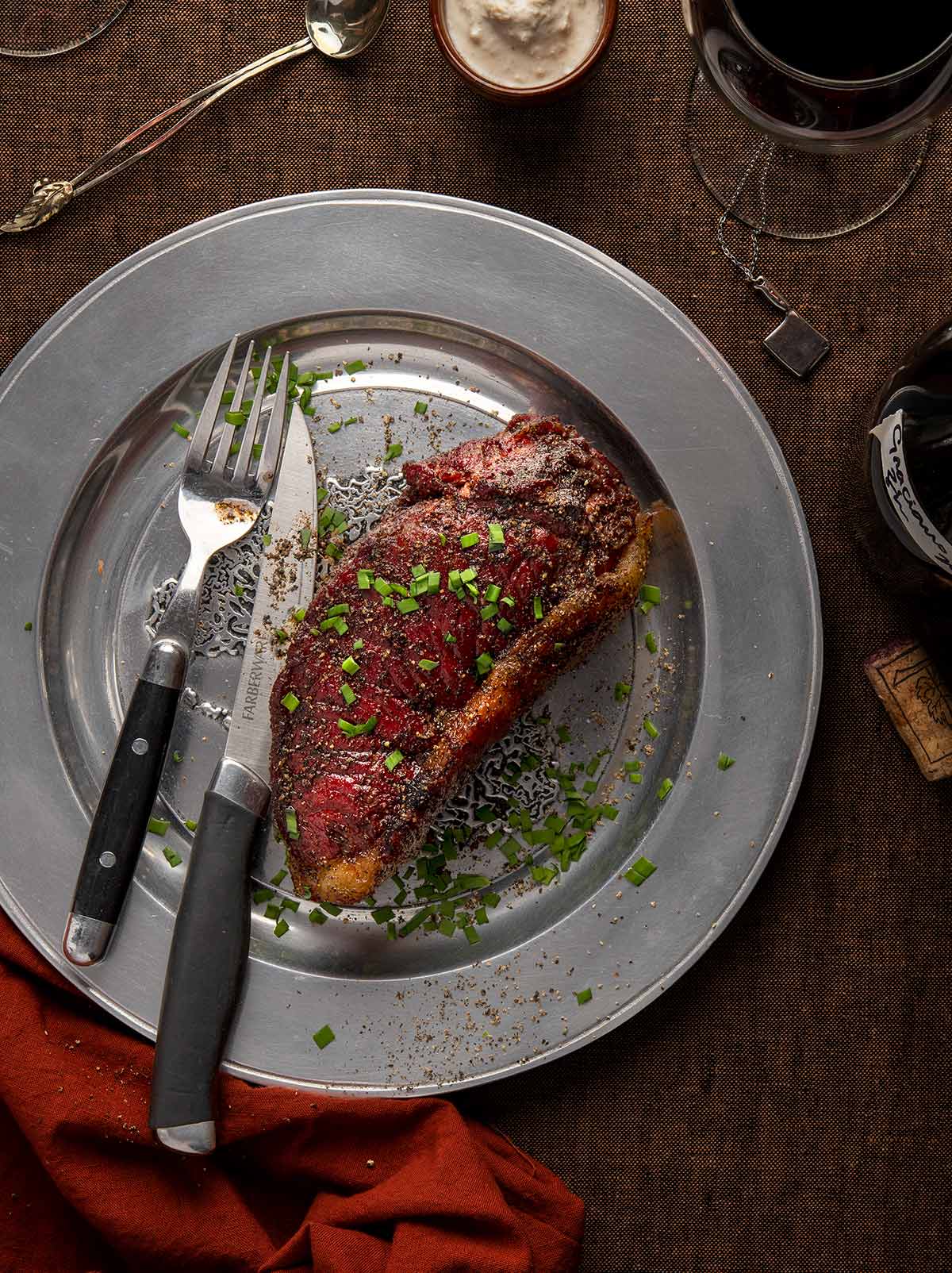Dry aging beef or other meats is a great way to improve the flavor and texture of the finished steak or roast. Here’s how to go about it at home, with an emphasis on dry aged venison.

WHY IT MATTERS. The shortest way to describe dry aging meat is that you are slowly removing moisture and allowing enzymes present in the meat to break down connective tissue, tenderizing it.
The longer this goes, the more flavorful amino acids are created by this process – to a point. Really old meat, even perfectly aged, will smell and taste like blue cheese. It’s not bad for you, but it can be, well, an acquired taste.
Taste, timing, temperature and humidity all change depending on whether you are dry aging poultry, red meat, pork or even fish.
(Want to listen instead? I did a whole podcast episode on dry aging meat with Jess Pryles.)
Hanging and Dry Aging Venison
Hanging and dry aging deer, elk and other cervids is perhaps the most controversial topic in all of deer hunting. Some swear by it, others who never age their deer swear by that. I’ve eaten deer aged more than a month and deer aged a couple days. Both were fine.
So what’s the real deal? What happens when you’re dry aging meat and what should you do once you have your critter up on the gambrels?
(Here’s a full discussion, with the science, on hanging pheasants and other game birds.)
IMPORTANT NOTE. Remove the tenderloins! They don’t need aging, and if you leave them on the carcass while aging, the rind that forms will need to be trimmed, and then there will be nothing left.
If you had the ultimate set up for dry aged venison, it would look something like this. You’d shoot your deer in weather somewhere below freezing. You gutted it close to the truck and got it to your locker. Yes, to properly age meat you need a walk-in cooler or locker. More on that in a bit.
You’d hang your deer in the skin for up to four weeks between 33°F and 37°F, with the humidity in the cooler somewhere around 65 to 75 percent. Then you’d skin the deer and butcher as normal.
Why is this perfect?
- The deer cooled down quickly after the shot.
- The animal was hung in a perfect environment. You need humidity or the carcass will desiccate. You need it to be cold or it will invite bacteria. Aging, remember, is enzymatic, not bacterial.
- You kept the skin on, which prevents that rind from forming on the outside of the meat. That rind needs to be cut away in dry aging, often resulting in significant meat loss.
- Three to four weeks has been shown in a number of studies to be the best combination of tenderness and “dry age-y” flavors most of us love.
Sadly, this ain’t happening for most of us, including me.
First problem: Most of us don’t have a locker. That can be solved with a friendly butcher, and I’ve seen many places in this country with rural meat lockers that the butcher will let you use for a small fee. I know a couple zealots who have built home walk-ins, and to them I say, rage on! There are a few other solutions, too.
Got a spare fridge in the garage? You know, the one with all the beer in it? Drink the beer, clean it out really well – bleach, or something anti-bacterial – take out all but the top rack. Quarter your deer and age the pieces in that fridge by suspending them from the top rack with twine.
BEST PRACTICES. Hang just the back legs and backstrap, ideally on the bone. Save the front shoulders for braises, stews, barbacoa, grinding, etc. Also remove the shanks.
This is important: You will get the most benefit out of dry aged venison or any other animal if you’re only dry aging the parts you intend to eat rare to medium. Any part you intend to cook a long time doesn’t need to be dry aged.
You certainly can dry-age shanks, shoulder and neck, but it’s a lot of space and your benefit is limited.
Easier Dry Aging
Another option is to skin the animal, break it down into big pieces – legs, plus body – and keep it over ice in a cooler for at least 24 hours and normally 48 to 72 hours. Then I will break the animal down and then age the pieces in the fridge, in plastic containers, for another few days. Only then do I vacuum seal them.
Let me walk you through my reasoning. I live in California, and our A Zone deer season starts in August. Daytime temperatures can top 100°F routinely. Not ideal deer hanging weather. Even our late season temps are rarely cooler than 35°F. So the need to cool the carcass is serious. Gut and skin quickly.
Melting ice water on meat is bad. The water will likely be about 40°F or even warmer, and it will allow any bacteria on the meat to start growing. Water will also wash out the meat itself, making it pale and tasteless. So you need to keep the meat off the melt water if at all possible. It won’t be ruined if it gets a little wet, but it’s not ideal.
Initially, I use burlap sacks or plastic bags to shield the meat. Then, when I am doing the preliminary aging of the primals (legs, etc.) I set them in a large, open plastic container inside the cooler. If you have a big deer, you could have several coolers going at once. Occupational hazard.

Wait to Butcher
Why not butcher immediately then? Because you never, ever want to butcher an animal while it is still stiff in rigor mortis. (This includes fish, by the way.) Doing so will result in tough meat, especially if you freeze it right away. The process is called shortening and in the home environment, you just need to let rigor take its course. Patience.
After the meat has relaxed for a day or three, you can butcher. You can then move on to wet or dry aging.
Wet Aging
Wet aging is what the supermarket industry does to the meat you buy there. The animal is aged a few days, then butchered, then vacuum sealed and kept refrigerated for up to a few weeks.
After a month or so, the meat will get weirdly sour, and not in a good way. The meat will become tenderer than absolutely fresh meat over this period, but it will not develop the aroma, complexity or melt-in-your-mouth tenderness of dry aging.
Keeping larger roasts, whole backstraps, etc., in the fridge for up to a week before vac sealing, gives you a hybrid dry age. It’s not as long as a real dry age, but nor is it as difficult. The venison or other meat loses some moisture, but you don’t get a rind so you need not trim before vacuum sealing.
True Dry Aged Venison
I do try to dry age venison every season — at least a few choice roasts and the backstrap. If you want to do this, you will need to commit to aging at least 10 days because very few flavor changes happen before one week.
Again, if you have a locker, you can age the whole carcass before butchering. This is good, but it’s not how they do it in the steakhouse.
If you want to age venison the way they age steak, you do need to cut the carcass into sub-primals, i.e., a whole backstrap (or one sliced in two for an elk or moose), a long length of chops, ideally still on the bone. A big roast, or a whole hind leg without the shank is a good option, too.
Why do this partial breakdown? Because you get better airflow and moisture loss this way, which leads to better flavors in the long run. And you must leave any fat cap on. This is vital. The fat protects the meat. You will trim a lot of it off later, but you need it now so you don’t lose meat.

Dry Aging the Easy Way
I happen to have a Dry Ager, a very nice, very fancy dry aging unit, the sort they use in steakhouses. It’s amazing, set-it-and-forget-it, and works really well with any sort of dry aging, not just dry aged venison.
Alas, it ain’t cheap. German engineering rarely is. Ask the folks with Leica binoculars. If you can afford a Dry Ager, I highly recommend it.
But for nearly two decades, I did my dry aging on the cheap.
Let’s go back to your fridge. Ideally you use the spare beer fridge in the garage, because aging meat smells – and can pick up odors from all the other food in the refrigerator. Set the fridge so the temp inside is about 33°F to 35°F. This is colder than normal, but still doable for a normal fridge. Set the large pieces of venison on a rack. They must be elevated for good airflow.
Set a pan of salty water in the fridge somewhere, to promote decent humidity. If it evaporates, refill it.
A better route is to spend a little money for a temperature and humidity regulator, like this one. It’s less than $100 and lets you control both — remember dry aging for a long time requires high humidity, and a fridge is naturally pretty dry.
In a perfect world, you would have a fan in the fridge. I’ve tried battery-operated fans and they are frustrating. The batteries seem to run out every other day, and yes, you can recharge them, but it’s a pain. Better to have a little fan with a power cord you can snake out the side of the fridge and into an outlet. You might need to cut a small notch in the rubber seal on the side of the fridge door to do this.
Or, just keep beer in the fridge — only beer, because other foods can contaminate your dry aged venison, or vice versa. Every day when you open it to get a brew, you are creating airflow. Works pretty well.
How Long?
Now, you wait at least 10 days, but honestly, real dry aged venison flavor doesn’t happen until three weeks, and a month is better. If you really like that funky-cheesy flavor of old meat, you can go up to 90 days, but that’s pushing it.
Sometimes you get mold, sometimes not. Most mold is harmless, unless it’s black.
Keep an eye out for black mold. It’s bad. Really bad. As in, toss the meat if you see more than a tiny spot. If you do see black mold and can catch it very early, scrape the spot clean with a knife and paper towels and hit the spot with a paste of salt and vinegar. Other molds are fine.
Dry aging can go longer than a couple months, but you will need to coat your meat in melted tallow or lard to protect it. Once the fat hardens, it will slow dehydration considerably. Some high-end restaurants then age old animals like dairy cattle or a decade-old moose for up to six months!
When you are ready, you need to trim off the gnarly, often moldy outside of the venison. Usually you will need to slice off about ¼ inch or so – see why you don’t want to do this with smaller cuts? Too much meat loss.

Final Dry Aging Tips
- The older the animal, the longer the hang time and the longer the aging process. Does and cows, too. Shoot a matron cow elk and you will want to hang and age it as long as a bull.
- Know that when you cook dry aged venison or other meats, the moisture loss will be noticeable — less sizzle in the pan. Dry aging also helps a steak brown more easily. Keep all this in mind when you cook or you might accidentally overcook your venison steak.
- The trim, so long as it’s not moldy, can go into the stockpot for venison stock, beef stock or whatever.
- Artificial tenderizers, like pineapple or papaya juice, don’t really work. All they do is attack surface of meat, making it mushy. Aging works from within.
- The so-called “dry aging bags” also are useless. Don’t buy them.
- Keep your meat in darkness. Sunlight oxidizes fat, especially venison fat, which is much higher in Omega-3 fatty acids; these oxidize faster than typical beef fat.















































